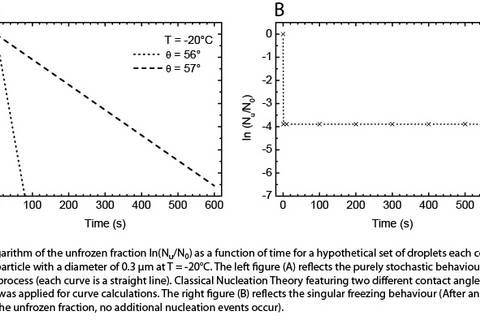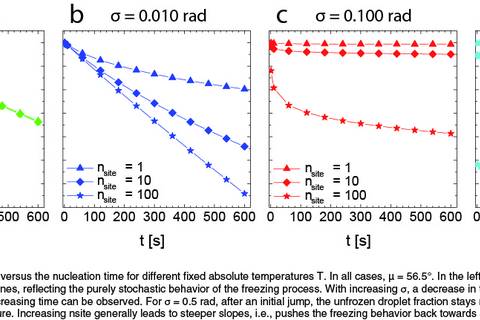Heterogeneous ice nucleation, a primary pathway to form ice in the atmosphere, directly influences both weather and climate. The major goal is to understand the heterogeneous freezing process at a fundamental level in order to describe this process in a physically-based way that will behave robustly in weather and climate models.
For several decades there has been conflicting evidence whether heterogeneous ice nucleation is:
a stochastic process in direct analogy to homogeneous ice nucleation (i.e., ice nucleation is time-dependent, see Fig. 1a) or
a singular process with nucleation taking place on specific particle surface sites, so-called active sites, at characteristic (i.e., deterministic) freezing temperatures (i.e., freezing is assumed to be time-independent, see Fig. 1b).
To explore the seeming contradiction, we introduce a conceptual model - the Soccer ball model - describing the freezing behaviour of an idealized population of ice nucleating particles. The model takes into account multiple nucleation sites on individual particles characterized by different nucleation rates. That means heterogeneous ice nucleation is viewed as always being stochastic. But the nucleation properties can vary between individual particles as well as on particles surfaces themselves with the probability for particles to feature similar properties, i.e., contact angles.
To do so, we consider a particle population of identical sized, spherical ice nuclei (IN), where each IN is immersed in a water droplet. The particles are divided into a number of surface sites nsite and each site is characterized by a given contact angle θ. We assume the contact angle probability density distribution function p(θ) to be Gaussian characterized through mean value μ and standard deviation σ. Using classical nucleation theory, the freezing probability of a supercooled droplet containing one immersed particle from the population is obtained by assuming independence of the probability of freezing on any given site.
Figure 2 displays the transition from a stochastic to an apparently singular behavior of the heterogeneous ice nucleation process, with this transition being due to a wider distribution of contact angles, or more generally speaking, ice nucleation related surface properties across the particle population. That means the emergence of singular or nearly singular behavior can be explained without appeal to active sites possessing characteristic freezing temperatures.
A simplified version of the Soccer ball model, which is computationally more efficient, is introduced in Niedermeier et al. (2014), where its applicability was also shown by implementing it into a parcel model.
Niedermeier, D., Shaw, R. A., Hartmann, S., Wex, H., Clauss, T., Voigtländer, J., and Stratmann, F.: Heterogeneous ice nucleation: exploring the transition from stochastic to singular freezing behavior, Atmos. Chem. Phys., 11, 8767-8775, doi:10.5194/acp-11-8767-2011, 2011.
Niedermeier, D., B. Ervens, T. Clauss, J. Voigtländer, H. Wex, S. Hartmann, and F. Stratmann: A computationally efficient description of heterogeneous freezing: A simplified version of the Soccer ball model, Geophys. Res. Lett., 41, doi:10.1002/2013GL058684, 2014.


